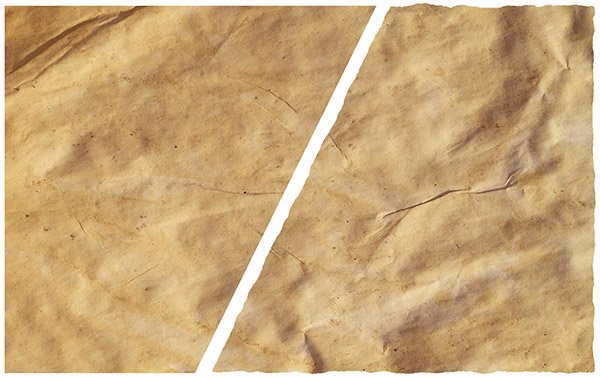The Rough Edges effect adds fractal roughness to the edges of a layer’s alpha channel. This is effective for distressing or weathering text or graphics, or for generating organic edges such as torn paper.

- Preset: Choose from one of the built-in presets as a starting point for the effect.
- Border Width: Adjusts the width of the area affected by the roughness, along the edge of the alpha.
- Type: Select the type of fractal used to generate the roughness pattern.
- Clouds: Creates a pattern of gradual transitions with dithered edges, reminiscent of clouds.
- Emboss: Uses a pattern similar to clouds, but then applies a height map, creating a stone-like texture.
- Energy: A pattern of thin, energetic strings.
- Fluid: Replicates a pattern similar to the caustics created by looking through a volume of water.
- Smoke: Soft, billowing shapes like the texture of smoke.
- Photocopy: Creates a rough edge surrounding the layer, and hides the center of the layer.
- Edge Color Amount: Controls what percentage of the warp area around the edge is replaced by a color of your choosing.
- Edge Color: Select the color used by the Edge Color Amount control above. You can use the eyedropper to choose a color from the viewer, or click the swatch to open a color picker and choose any color you prefer. You can also manually enter the color values for the red, green, and blue channels.
- Falloff: Adjusts the feathering along the warped edge, and how far the rough edge extends outward.
Fractal
- Seed: Randomizes the fractal pattern used to generate the rough edges, within the style created by the other settings. Each seed value creates a unique pattern.
- Interpolation: Choose the method used to build the pattern from the fractal geometry.
- Block: Creates a square, pixelated appearance.
- Linear: Applies more gradual transitions from one block to the next.
- Cubic: More dramatic gradients completely obscure the block pattern to create organic shapes.
- Exposure: Adjusts the exposure of the fractal noise on which the rough edge is based. Bright areas within the fractal noise are affected more strongly than dark areas. Positive values expand the rough edge, and negative values contract it.
- Offset: Shifts the entire range of tonal values in the fractal noise up or down. Values shifted beyond pure black or pure white will be clipped.
- Scale: Changes the granularity of the fractal noise, thereby affecting the size of the detail in the roughened edge.
- Axis Scale: Allows you to scale the pattern on each axis individually.
- X: Scales the width of the pattern without affecting the height.
- Y: Scales the height of the pattern, without affecting the width.
- Animation: Use these controls to introduce motion into the roughened edge.
- Wind Direction: Rotate the dial to select the angle toward which the animation will trend.
- Wind Speed: Set the speed of the motion toward the Wind Direction angle selected above.
- Noise Speed: Defines the speed at which the noise evolves, separate from the wind motion.
